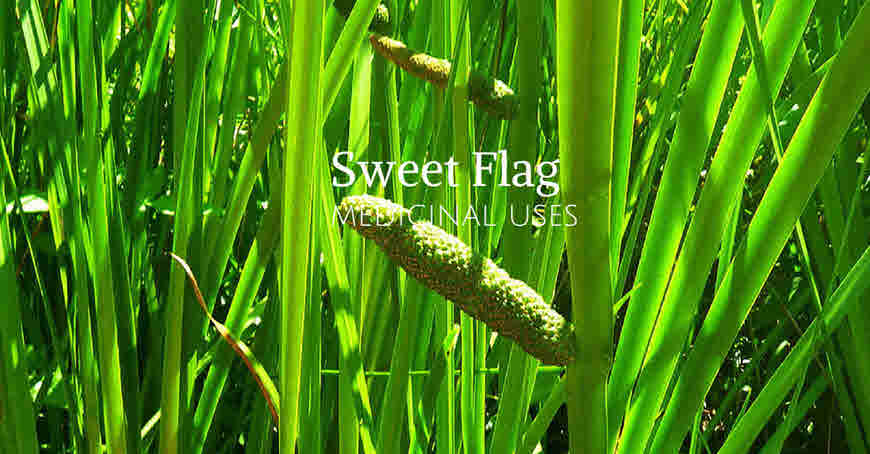Acorus calamus (Bach) is a well-known medicinal plant of aquatic habitats. For the medicinal purpose the root-stock of the plant are used. It indigenous to India and is found almost throughout India up to altitude of 1800 meters. It has aromatic leaves and rhizomes. Calamus is used to treat different clinical conditions such as digestive system problems, gas, bloating, bronchitis, fever, asthma, cough, rheumatism, etc. Its rhizome oil is nerve stimulant, sedative and analgesic.

In Ayurveda calamus is considered tonic for the brain, nervous system and cure for the digestive system ailments. Calamus is ingredient of Ayurvedic medicine Brahmi Vati which is used for treating epilepsy, hysteria and mental retardation.
Scientific Classification
- Kingdom: Plantae – Plants
- Subkingdom: Tracheobionta – Vascular plants
- Superdivision: Spermatophyta – Seed plants
- Division: Magnoliophyta – Flowering plants
- Class: Liliopsida – Monocotyledons
- Subclass: Arecidae
- Order: Arales
- Family: Acoraceae – Calamus family
- Genus: Acorus L. – sweetflag
- Species: Acorus calamus L. – calamus
There are four types of Calamus used in herbal medicine viz. type I—Acorus calamus L. var. americanus, a diploid American var.;type II—var. vulgaris L. (var. calamus), a European triploid;type III and type IV—var. augustatus Bess. and var. versus L., subtropical tetraploids.
Description
Perennial, erect, aromatic herb, common on river banks and marshes, ascending to 1800 m;rhizome cylindrical or slightly compressed, about 2.5 cm in diameter, much-branched, externally light brown or pinkish brown but white and spongy within;leaves distichous, large, 1-2 m in length, base equitant, margin waved;spadix sessile, cylindric, densely flowered, not completely enclosed by spathe, spathe 15-75 cm in length, narrow, leaf-like;flowers small, bisexual;berries few-seeded;seeds oblong, albuminous.
Flowering and Fruiting: July-August;fruiting very rare.
Distribution: Throughout India;ascending the Himalaya up to 2000 m;Sri Lanka, Pakistan and Bangladesh.
Habit: Semi-aquatic or marshy, perennial herb.
Parts Used for Medicinal Purpose: Roots.
Chemical contents
Dry rhizome:1.5-3.5% of a yellow aromatic volatile oil-calamus oil;the oil contains β-asarone, small quantities of sesquiterpenes and sesquiterpenes alcohols;Rhizome: also contains choline (0.26%), flavone, acoradin, 2, 4, 5-tri-MeObenzaldehyde, 2, 5-di-MeO-benzoquinone, galangin, calameone, acolamone, isoacolamone, epoxyisoacoragermacrone;Aerial parts: lutcolin-6, 8-cdiglucoside;chemical constituents vary in ecotypes and polyploides.
Other names of Acorus calamus
- Sanskrit: Vacha, Bach, Bhuta nashini
- Ayurvedic: Vacha, Ugragandha, Ugra, Golomi, Shadgrantha, Shataparva, Tikshnagandha, Kshudra-patra, Mangalya, Ghorbach
- Unani: Waj-e-Turki, Waj
- Siddha/Tamil: Vasambu
- Hindi: Bach, gorabach, Safed Bach
- Assamese: Themepr
- Bengali: Bach
- Marathi: vekhand
- Kannada: bajegida
- Malayalam: Vashampe
- Kannada: bajegida
- Malayalam: Vashampe
- Tamil: vashambu
- Telugu: vasa
- English: The sweet flag
Benefits of Vach Root Powder
- It is a nervine tonic. As a stimulant or nervine it is used in combination with other medicines in low fevers, epilepsy and insanity.
- It improves functioning of brain and nervous system.
- It is diuretic in action.
- It reduces Vata/wind.
- It reduces Kapha/mucous and thus helps to cure excessive cough and mucous in the body.
- It increases Pitta and thus helps to cure indigestion.
- It detoxifies the body.
- It has wormicidal action.
- It is antiseptic.
- It is sedative and analgesic.
- It is antiasthmatic.
- It is also used as an antidote in snakebite.
Important Medicinal Properties of Sweet flag root powder
- Alterative
- Anthelmintic
- Anti-parasitic
- Antiperiodic
- Anti-rheumatic
- Antispasmodic
- Aphrodisiac
- Astringent
- Anticonvulsant
- Brain tonic
- Cardiac tonic
- Carminative
- Diaphoretic
- Diuretic
- Emetic
- Errhine
- Expectorant
- Hypotensive
- Insecticide
- Purgative
- Styptic
- Sedative
Medicinal use of Vach/Bach/Sweet flag root powder
The rhizome of Vach has stomachic, carminative and nervine in smaller doses. It is used in the treatment of diseases of the body and mind. It is given to improve memory and functioning of brain.
Intake of Calamus root powder reduces Vata and Kapha but increases pitta. Vach is used in the treatment of paralysis, epilepsy, retention of urine, intestinal worms, cough, bronchitis, diarrhea, gas, hair loss, indigestion, Vocal problems and various skin disorders.
Mental stress, improving memory
Vach root powder is taken with honey, twice a day.
Cholera
Take calamus root (1 tbsp), clean it and boil in water (1200 ml). Filter and drink 3-4 times a day (half cup at a time).
Headache, joint pain
Apply paste of calamus root on the affected areas.
Fever, cough
Its paste is applied directly on the forehead during fever.
Diarrhoea, Indigestion, gas
Take Bach root powder (2 pinch) with honey in the morning.
Speech problems
The root powder is given for two months in the recommended dosage.
Nervous system problem
Take bach root powder (2 pinches) with water in the morning for a month.
Syphilis
Mix calamus root powder, Ashwagandha powder and Costus powder in equal quantities. Mix this powder with ghee and apply externally on the affected areas.
Boils, wounds
Apply calamus root powder on the affected areas.
For acne
Apply a paste of Lodhra bark, coriander and Acorus calamus.
Side-Effects/Warning/Caution
If taken in excess it causes emesis.
Internally it should be taken in precise dosage only.
can you explain the difference between meethi and kadvi bach?
there seems to be a very big price difference between the two